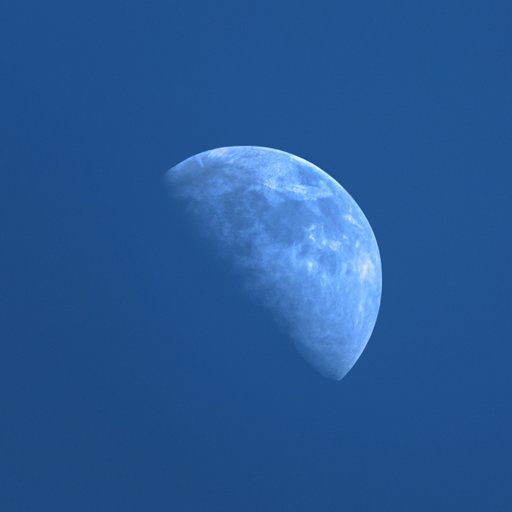I. Introduction
Have you ever looked up at the sky during the daytime and spotted the moon? Did you wonder how it got there and why it was visible during the daylight hours? Seeing the moon during the day is a common occurrence, yet few people understand the science behind it. In this article, we will explore the reasons behind the moon’s visibility during the day and the factors that affect its appearance.
II. The Science Behind Why We Can See the Moon During the Day
The moon is visible during the day because of the way sunlight reflects off its surface. The moon doesn’t have any light of its own; it merely reflects the light of the sun. So when the sun shines on the moon, some of that light reflects back towards the Earth, allowing us to see the moon in the sky.
But why can’t we always see the moon during the day? This is because the brightness of the sun can often overpower the fainter reflected light of the moon, making it difficult to see. However, there are times when the moon’s brightness is strong enough to overcome this and become visible during the day.
III. The Myth of the Moon only Being Visible at Night: Debunked
While many people think of the moon as a celestial object only visible at night, this is a common misconception. In fact, the moon is visible during both day and night, depending on its position in relation to the sun and Earth.
This myth can be attributed to the fact that the moon is more easily visible at night when the surrounding sky is dark, making it easier for our eyes to spot. Additionally, cultural beliefs and folklore may perpetuate this idea of the moon as a nighttime-only object.
IV. Why Seeing the Moon During the Day is More Common Than You Think
While many people may not notice the moon during the day, it is actually quite common to see it in the daylight hours. In fact, the moon is visible during the day for approximately half of each lunar cycle.
However, there are a few reasons why individuals may not notice the moon during the day. One reason is that it may be too small or faint to be easily visible, or it may be obscured by clouds or other atmospheric conditions. Additionally, people may not be in the habit of looking for the moon during the day, as it is often associated with nighttime.
V. The Surprising Ways the Moon’s Position Affects Its Visibility During the Day
The moon’s position in the sky can have a significant impact on its visibility during the day. The position of the moon is influenced by its orbit around the Earth, as well as the Earth’s rotation and position in relation to the sun.
For example, during a new moon or a full moon, the moon is in alignment with the sun and Earth, making it more visible during the day as it reflects the sun’s light. However, during a crescent moon or gibbous moon, the moon’s position may be such that it is more visible at night or during twilight hours than during the middle of the day.
VI. What Causes the Moon’s Appearance During the Day and How It Differs From Nighttime
The appearance of the moon during the day can often be quite different from how it appears at night. During the day, the moon may appear much brighter and larger due to the amount of sunlight reflecting off its surface. Additionally, the sky around the moon may appear blue or hazy, depending on atmospheric conditions.
At night, the moon’s appearance may be more muted, as there is less sunlight reflecting off its surface. Additionally, the sky around the moon may appear dark or black, providing greater contrast to the moon’s appearance.
VII. The Curious Phenomenon of Seeing the Moon During the Day: An Exploratory Study
Research has shown that seeing the moon during the day can have a unique impact on individuals, leading them to ponder the mysteries of the universe and their place within it. This phenomenon has been explored by scientists and thinkers throughout history, leading to a deeper understanding of our relationship with the cosmos.
VIII. Expanding Your Understanding of Lunar Visibility: Learning About the Moon’s Daytime Appearance
If you’re interested in learning more about the moon’s appearance during the day, there are plenty of resources available. Books, podcasts, and online articles can provide a wealth of information on the topic, while observatories and planetariums may offer opportunities to see the moon up close. Additionally, simply taking the time to observe the moon during the day can help to deepen your understanding of this fascinating celestial object.
IX. Conclusion
Seeing the moon during the day is a wondrous and common occurrence that has inspired curiosity and contemplation throughout history. By understanding the science and mythology behind lunar visibility, we can gain a deeper appreciation for our place within the vast expanse of the universe. So next time you spot the moon during the day, take a moment to reflect on the mysteries of life and the cosmos.
